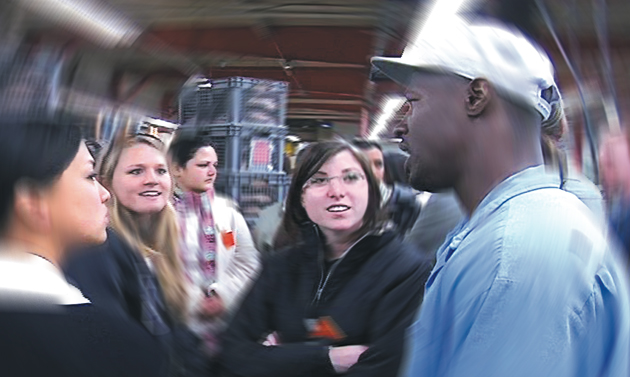Behind Bars
Paul Sutton's students confront the reality of prison life.

Reprinted from 360 magazine, summer 2006
When Criminal Justice Professor Paul Sutton leads San Diego State students on a tour of California prisons, he challenges them to find the gorilla.
It’s a reference to a video clip that tests observation skills. Viewers are instructed to count the number of times a white-shirted person touches a beach ball. Here’s the catch: most viewers, intently focused on the white shirts, not only ignore the black-shirted people, but also fail to notice a big, black, gorilla ambling among the humans.
Sutton never misses the gorilla. For 27 years, he’s been taking SDSU criminal justice students to visit California’s harshest prisons. Leaving campus at dawn on a Monday, they travel by bus to Soledad, Folsom, San Quentin and four or five other high security institutions and return to SDSU on Friday night, exhausted and frequently changed.
“I can’t shake it. That feeling that thinks are never going to be the same again,” Samantha Arlen wrote in an essay summarizing her tour with Sutton and fellow students. “I walked into the prison tour with my beliefs and values firmly held in my physical, mental and emotional being, and came back struggling to find a way to put them back together so that they made sense again.”
Sutton hopes for this kind of reaction. Above all, he wants students to understand the realities of prison life before they choose a career in criminal justice. Though he trusts the efficacy of the system, he frequently criticizes its policies and practices, particularly the high salaries paid to correctional officers.
Yet, the officers are some of his biggest fans. Respect hangs in the air when they greet Sutton at the prison door. His is the only class in the country that immerses students in the prison experience for a full five days and offers them the rare opportunity to talk face-to-face with murderers.
Kyle Roche, an aspiring lawyer, recalled his meeting with one inmate at the California’s Men’s Colony, a “progressive” prison nestled in a peaceful valley near San Luis Obispo. “I found myself inside a cell with four other students and an inmate, Mark, who began speaking about life in a cell. Much to my astonishment, I began to like Mark and even to forget that he committed an offense.”
Roche described the scene, minutes later, when Mark tells the group of his conviction for murdering his friend and crime partner. “Speechless, I did not know what to do or what to say. It is an indescribable feeling…what I believed about a murderer my whole life vanished.”
Though students are disarmed by some of the prisoners, they encounter many who fit the hardened inmate stereotype to perfection. It’s difficult to remain unintimidated within the walls of San Quentin and Folsom.
Student Glenn Robinson talked about the experience: “Most every prisoner would stop what they were doing and stare at us. Nowhere was this more evident than in the dorm at San Quentin. The longer (our guide) spoke, the more people formed around us in a semi-circle until there were literally hundreds of eyes looking us over. Several of them were talking softly while laughing with their friends. (It was) one of the more awkward moments of my life.”
Despite the fear factor, students give the prison tours rave reviews. A number of Sutton’s former students say the experience crystallized their decision to become correctional officers. Others have left the tour bus resolved to change the criminal justice system. One way or another, by the end of the week, each student finds his gorilla.
View an edited version of Sutton's new documentary on the California prison system.



